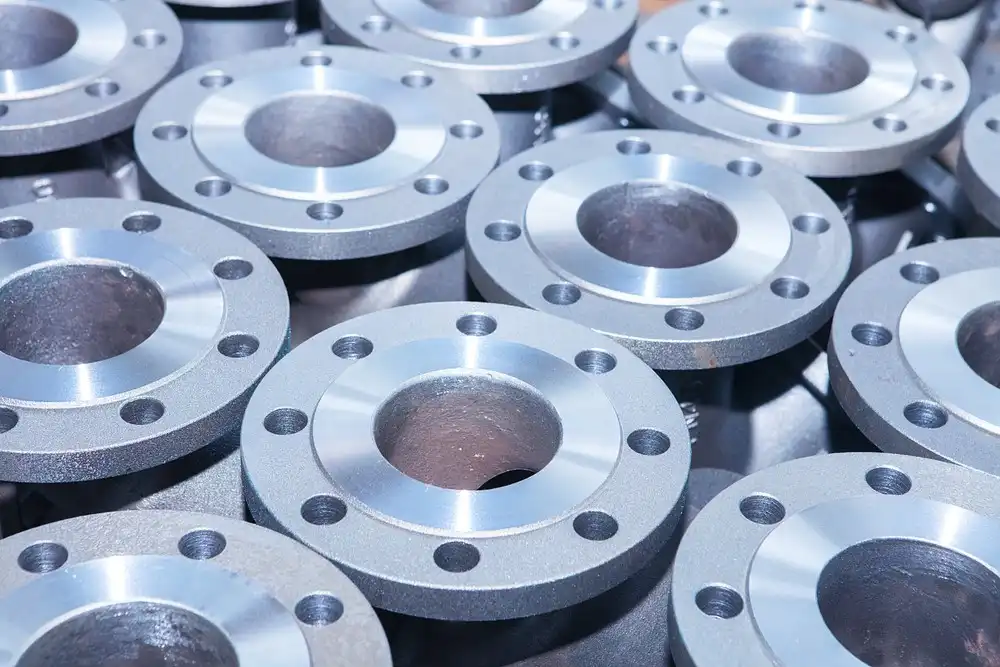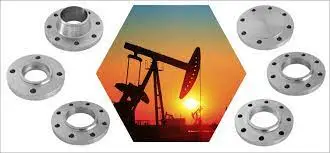What materials resist corrosion best in oil and gas flange systems?
Austenitic steels are strong and don't rust, just like 316L and 317L. A lot of people in the oil and gas business use them. That's why salt makes them less likely to break or split.
Austenitic Stainless Steels
Austenitic stainless steels, such as 316L and 317L, are used by many in the oil and gas industry because they are strong and don't rust. That's why salt makes them less likely to split or break.
Duplex Stainless Steels
Nickel-based metals, such as Inconel 625, 725, and 718, can handle acidic liquids very well. They can be used when things go badly. Underground or in places where salt stress corrosion cracking is expected to happen is the only place these metals should be used.
Nickel-Based Alloys
Nickel-based metals, such as Inconel 625, 725, and 718, can easily handle acidic liquids. When things go wrong, you can use them. A lot of the time, these metals are used in places, like gas flanges, where other materials might fail, like in bad service and high temperatures.
Considerations for Material Selection
When picking out materials for gas flanges, it's important to think about things like
- What chemicals are in the process fluids?
- Temperature and pressure for use
- There is either CO₂ or H₂S in the air, or another dangerous gas.
- How acidic it is and how much salt it has
- Needs for mechanical stress
- Costs over a person's whole life
Engineers can pick the best materials that won't rust for oil and gas flanges by carefully considering these things. In the long run, this makes sure that the transportation systems are safe and work well.
Stainless steel, duplex, and Inconel flanges for offshore and sour service pipelines
Offshore and sour service pipelines are some of the toughest places for gas valves and other pipeline parts to work. Materials must not rust easily and be able to move easily because they will be exposed to hydrogen sulfide (H₂S), have a lot of salt in them, and be heated and pressed to high temperatures.
Stainless Steel Flanges in Offshore Applications
Out at sea, austenitic stainless steels like 316L and 317L are often used in places that need a little rust protection. These types are pretty resistant to normal rust and cracking in salt water. Higher-alloyed austenitic types like 904L or 6Mo stainless steels may be used for more difficult marine uses because they are better at resisting stress corrosion cracks caused by salt.
Duplex Stainless Steel Flanges for Enhanced Performance
A lot of nautical and food service equipment is made of duplex stainless steels because they are strong and don't rust. Standard duplex grade 2205 is better at stopping chloride stress corrosion cracks than austenitic grades. This makes it a good choice for many naval settings. For even rougher conditions, super duplex types like 2507 are stronger and less likely to rust, which could help builders cut down on weight.
Inconel Flanges for Extreme Environments
In the most aggressive offshore and sour service environments, nickel-based alloys like Inconel 625 and 725 are often the materials of choice for gas flanges. These metals are very strong against a lot of different toxic substances, like chlorides, H₂S, and other harsh chemicals that are used in oil and gas production. Inconel flanges work especially well in sour service situations where temperatures are high and other materials might crack from sulfur stress.
Material Selection Considerations for Offshore and Sour Service
When selecting materials for offshore and sour service pipelines, it's essential to consider the following factors:
- H₂S partial pressure and concentration
- Chloride content and temperature of the environment
- Operating pressure and mechanical stress requirements
- Possible weathering and rust
- What I think about building and welding
- Value for money and success in the long run
Engineers can choose the best seal materials for use in harsh service and naval settings by giving these things a lot of thought and reading industry standards like NACE MR0175/ISO 15156. This makes sure that the transportation methods are safe and work well over time.

Surface coating and cathodic protection techniques for gas flanges
For gas flanges used in oil and gas uses, it is important to choose base materials that don't rust. However, extra security can make them last longer and work better. A lot of people use surface treatment and cathodic protection to add an extra layer of protection against rust in tough conditions.
Surface Coating Techniques for Gas Flanges
Surface coatings can significantly improve the corrosion resistance of gas flanges, even when applied to less noble base materials. Some effective coating techniques include:
- One way to add thick, well-bonded layers of metal or clay that are very hard to wear down or rust is with High Velocity Oxygen Fuel (HVOF) blasting.
- To protect against harmful things, nickel or chrome finishing can be used.
- Heavy-duty epoxy coats don't react badly with chemicals and can be put on many different types of base materials.
- PTFE or PFA covers that are safe and won't stick don't stick and are very safe.
You should think about the temperature range, where the gas flanges will be used, and how likely it is that they will break while being used or put before you choose a finish.
Cathodic Protection for Subsea and Buried Pipelines
It is the cathode of an electrochemical cell that keeps metal items from rusting. This is called cathodic protection. This method is particularly effective for protecting subsea and buried pipeline components, including flanges. There are two main types of cathodic protection:
- Anode for Sacrifice One thing that SACP stands for is cathodic protection. Anodes in this method are made of metals that rust quickly, like zinc, magnesium, or aluminum. They protect the steel parts of the pipeline.
- Current Cathodic Protection (ICCP): An outside power source drives a current through the building with this method. We are done with it, so it won't rust.
In the water, sacrificial anode devices are often the best choice because they are safe and simple to use. If you have long lines or gas flanges or are in a place where safety calls for a higher current level, ICCP systems may work better.
Combining Corrosion Protection Techniques
You can use a mix of materials that don't rust, surface treatments, and cathodic protection to protect gas lines and other pipeline parts as much as possible. There are many levels to this method, so even in the worst cases, there is cover and long-term safety.
Though these safety steps are being taken, it's important to remember:
- It is important that the main material, the layer, and the cathodic protection system all work well together.
- Cathodic protection could cause coatings to break down or separate.
- Needs for inspection and repair of the safety systems
- A look at the life cycle costs of different security measures
By carefully choosing and using the right rust protection methods, workers can make gas flanges last a lot longer and lower the risk of leaks or problems in oil and gas pipeline systems.
Conclusion
It is very important to pick the right materials and safety measures for oil and gas gas valves so that pipeline systems are safe and work well over time. Stainless steels, duplex alloys, and nickel-based superalloys are some of the high-performance materials that engineers can choose from. They do this by taking into account things like the acidic environment, the working conditions, and the cost-effectiveness of the material. Surface sealing and cathodic protection systems can also be used to make gas flanges less likely to rust, especially when they are used underground or offshore.
Ra Young is a big company that makes industrial pipe parts, so they know how important it is for pipes used in oil and gas that they don't rust. To meet the tightest needs of the industry, we offer a large range of high-quality flanges made from stainless steel and other special metals. Because they are certified by GOST-R and SGS, you can be sure that our products will always be of high quality and work well.
RAYOUNG helps EPC workers, dealers, and end users pick gas flanges that will work well for their projects and not rust by giving them expert advice on which materials to use and how to solve problems in unique ways. We care about new ideas, quality, and making sure all of our clients are pleased. In other words, you'll always get the best goods for your wants. This will help you keep your projects safe, grow your business, and meet safety standards.
FAQ
1. What is the most corrosion-resistant material for gas flanges in sour service applications?
People often believe that nickel-based metals, like Inconel 625 or 725, are the best for gas valves because they don't rust when used in rough circumstances. People who live in places with a lot of hydrogen sulfide can stop sulfide stress cracks and other types of aging very well.
2. How does duplex stainless steel compare to austenitic stainless steel for offshore gas flanges?
Out of the country, duplex stainless steels work better than austenitic ones because they are harder and less likely to rust. The fact that they don't break or pit as easily when exposed to chloride stress rust makes them perfect for use in saltwater. For sure, the pick will depend on how the business is run and how much it costs.
3. Can surface coatings replace the need for corrosion-resistant base materials in gas flanges?
Surface covers are a great way to protect against corrosion, but they shouldn't be the only way that gas tubes are kept from rusting in important scenarios. The best long-term safety and reliability usually come from using base materials that don't rust and the right top coats.
Ensure Long-lasting Performance with Corrosion-Resistant Gas Flanges | RAYOUNG
If you don't want your oil and gas pipes to rust, you need to make sure you get the right gas valves. We have a lot of corrosion-resistant flanges at RAYOUNG that are made to last in the worst circumstances. You should not let rust get in the way of your work. There are trained people here who can help you pick out the right safety gear and other things. They'll last a long time and keep you safe. Contact RAYOUNG today at info@hb-steel.com to discuss your gas flange requirements and discover how our high-quality, corrosion-resistant solutions can safeguard your investments for years to come.
References
1. NACE International. "Corrosion in the Oil and Gas Industry: An Overview." Materials Performance, 2019.
2. American Petroleum Institute. "API Specification 6A: Specification for Wellhead and Christmas Tree Equipment." 21st Edition, 2018.
3. Stainless Steel World. "Duplex Stainless Steels in Oil and Gas Applications." Technical Report, 2020.
4. Schweitzer, P.A. "Corrosion of Linings and Coatings: Cathodic and Inhibitor Protection and Corrosion Monitoring." CRC Press, 2017.
5. NACE International. "NACE MR0175/ISO 15156: Materials for use in H2S-containing Environments in Oil and Gas Production." 2015.
6. Special Metals Corporation. "Inconel Alloy 625 Technical Bulletin." 2018.







